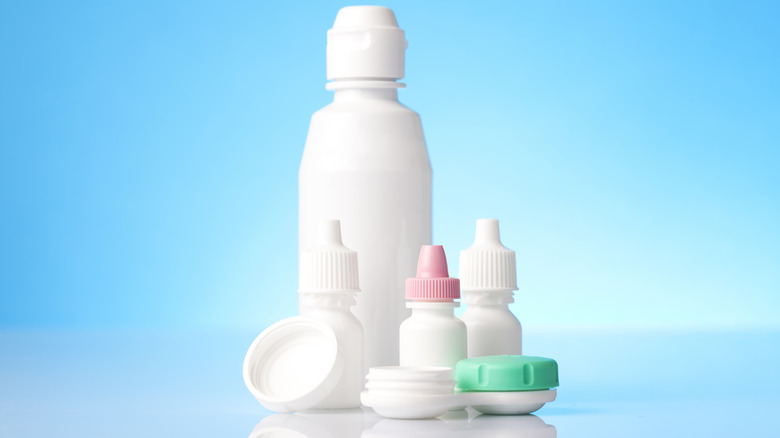The Truth About What's Really In Contact Lens Solution
Contact lenses are deceptively simple devices. Although theorized by Leonardo Da Vinci in 1508, direct in-eye vision correction long remained the stuff of fantasy (via Piedmont Eye Center). Different versions were proposed over the next few centuries until the first soft contact lens was perfected in 1971.
Since then contact lenses have grown in popularity. The CDC estimates that there are 45 million contact wearers in America alone. As widespread as the practice has become, there's still a surprising number of people who are unaware of the risks associated with contact use. One in 500 contact users will experience a serious eye infection as a result of contact use, according to the CDC. And of wearers polled in 2016, 99% stated that they do not clean their contact lenses or follow the recommended hygiene practices.
It's really not surprising that most contact users probably aren't aware of what exactly is in their solution. Additionally, many may not be aware that different solutions perform different functions. More surprising still, some people may actually be allergic to their contact solution.
Multipurpose solution versus saline solution
There are several contact solution options available, and most of them are available for off-the-shelf purchase in drugstores. These include multipurpose solutions, saline solutions, and daily cleaning solutions. Other products — like hydrogen peroxide-based solutions, enzymatic protein removers, and Rigid Gas Permeable (RGP) solutions for hard contacts — are also available but generally only after consulting a doctor (via CDC). Of all these solutions, however, two are by far the most common: multipurpose and saline.
Although multipurpose and saline solutions appear interchangeable at first glance, they are anything but. Woodhams Eye Clinic describes multipurpose solution as any combination of a wetting agent, binder, buffer, and preservative. They serve not only to wet the contacts but to clear away buildup as well. Saline solution, on the other hand, is described as saltwater that is pH-balanced and nothing more. Unlike multipurpose solution, saline solution will not clean away buildup and is only useful for wetting contacts prior to application.
While saline solutions are straightforward, multipurpose solutions can contain an array of chemicals. Some of these, according to the Cleveland Clinic, may set off allergic reactions in contact wearers. If a person's eyes become irritated after wearing contact lenses, the Clinic suggests speaking to an eye care professional and, in the meantime, switching contact solutions.


